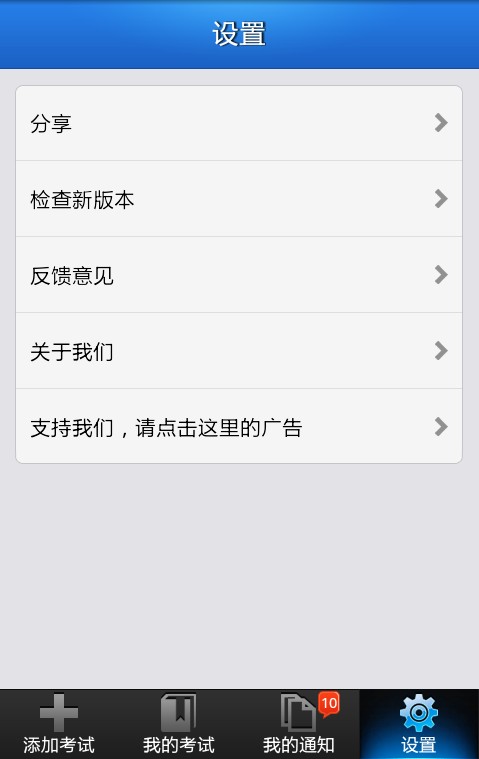在项目中我们会经常遇到这种圆角效果,因为直角的看起来确实不那么雅观,可能大家会想到用图片实现,试想上中下要分别做三张图片,这样既会是自己的项目增大也会增加内存使用量,所以使用shape来实现不失为一种更好的实现方式。在这里先看一下shape的使用:
<?xml version="1.0" encoding="utf-8"?>
<shape xmlns:android="http://schemas.android.com/apk/res/android"
android:shape="rectangle"
>
<!-- 渐变 -->
<gradient
android:startColor="#B5E7B8"
android:endColor="#76D37B"
android:angle="270"
/>
<!-- 描边 -->
<!-- <stroke android:width="1dip"
android:color="@color/blue"
/> -->
<!-- 实心 -->
<!-- <solid android:color="#FFeaeaea"
/> -->
<!-- 圆角 -->
<corners
android:bottomRightRadius="4dip"
android:bottomLeftRadius="4dip"
android:topLeftRadius="4dip"
android:topRightRadius="4dip"
/>
</shape>
solid:实心,就是填充的意思
android:color指定填充的颜色
gradient:渐变
android:startColor和android:endColor分别为起始和结束颜色,ndroid:angle是渐变角度,必须为45的整数倍。
另外渐变默认的模式为android:type="linear",即线性渐变,可以指定渐变为径向渐变,android:type="radial",径向渐变需要指定半径android:gradientRadius="50"。
stroke:描边
android:width="2dp" 描边的宽度,android:color 描边的颜色。
我们还可以把描边弄成虚线的形式,设置方式为:
android:dashWidth="5dp"
android:dashGap="3dp"
其中android:dashWidth表示'-'这样一个横线的宽度,android:dashGap表示之间隔开的距离。
corners:圆角
android:radius为角的弧度,值越大角越圆。
OK,下面开始自定义listview实现圆角的例子:
首先在drawable下定义只有一项的选择器app_list_corner_round.xml:
<?xml version="1.0" encoding="utf-8"?>
<shape xmlns:android="http://schemas.android.com/apk/res/android"
android:shape="rectangle"
>
<!-- 渐变 -->
<gradient
android:startColor="#B5E7B8"
android:endColor="#76D37B"
android:angle="270"
/>
<!-- 描边 -->
<!-- <stroke android:width="1dip"
android:color="@color/blue"
/> -->
<!-- 实心 -->
<!-- <solid android:color="#FFeaeaea"
/> -->
<!-- 圆角 -->
<corners
android:bottomRightRadius="4dip"
android:bottomLeftRadius="4dip"
android:topLeftRadius="4dip"
android:topRightRadius="4dip"
/>
</shape> 如果是顶部第一项,则上面两个角为圆角,app_list_corner_round_top.xml:
<?xml version="1.0" encoding="utf-8"?>
<shape xmlns:android="http://schemas.android.com/apk/res/android"
android:shape="rectangle"
>
<gradient
android:startColor="#B5E7B8"
android:endColor="#76D37B"
android:angle="270"
/>
<!-- <stroke android:width="1dip"
android:color="@color/blue"
/> -->
<!-- <solid android:color="#FFeaeaea"
/> -->
<corners
android:topLeftRadius="4dip"
android:topRightRadius="4dip"
/>
</shape>
如果是底部最后一项,则下面两个角为圆角,app_list_corner_round_bottom.xml:
<?xml version="1.0" encoding="utf-8"?>
<shape xmlns:android="http://schemas.android.com/apk/res/android"
android:shape="rectangle"
>
<gradient
android:startColor="#B5E7B8"
android:endColor="#76D37B"
android:angle="270"
/>
<!-- <stroke android:width="1dip"
android:color="@color/blue"
/> -->
<!-- <solid android:color="#FFeaeaea"
/> -->
<corners
android:bottomRightRadius="4dip"
android:bottomLeftRadius="4dip"
/>
</shape>
如果是中间项,则应该不需要圆角, app_list_corner_round_center.xml:
<?xml version="1.0" encoding="utf-8"?>
<shape xmlns:android="http://schemas.android.com/apk/res/android"
android:shape="rectangle"
>
<gradient
android:startColor="#B5E7B8"
android:endColor="#76D37B"
android:angle="270"
/>
<!-- <stroke android:width="1dip"
android:color="@color/blue"
/> -->
<!-- <solid android:color="#FFeaeaea"
/> -->
<!-- <corners
android:bottomRightRadius="4dip"
android:bottomLeftRadius="4dip"
/> -->
</shape>
listview的背景图片大家可以使用stroke描述,这里我使用了一张9PNG的图片,因为9PNG图片拉伸不失真。
定义好了圆角的shape接下来是自定义listview的实现:
package cn.com.karl.view;
import cn.com.karl.test.R;
import android.content.Context;
import android.util.AttributeSet;
import android.view.MotionEvent;
import android.widget.AdapterView;
import android.widget.ListView;
/**
* 圆角ListView
*/
public class CornerListView extends ListView {
public CornerListView(Context context) {
super(context);
}
public CornerListView(Context context, AttributeSet attrs, int defStyle) {
super(context, attrs, defStyle);
}
public CornerListView(Context context, AttributeSet attrs) {
super(context, attrs);
}
@Override
public boolean onInterceptTouchEvent(MotionEvent ev) {
switch (ev.getAction()) {
case MotionEvent.ACTION_DOWN:
int x = (int) ev.getX();
int y = (int) ev.getY();
int itemnum = pointToPosition(x, y);
if (itemnum == AdapterView.INVALID_POSITION)
break;
else {
if (itemnum == 0) {
if (itemnum == (getAdapter().getCount() - 1)) {
//只有一项
setSelector(R.drawable.app_list_corner_round);
} else {
//第一项
setSelector(R.drawable.app_list_corner_round_top);
}
} else if (itemnum == (getAdapter().getCount() - 1))
//最后一项
setSelector(R.drawable.app_list_corner_round_bottom);
else {
//中间项
setSelector(R.drawable.app_list_corner_round_center);
}
}
break;
case MotionEvent.ACTION_UP:
break;
}
return super.onInterceptTouchEvent(ev);
}
}
下面看一下列表布局文件setting。xml:
<?xml version="1.0" encoding="utf-8"?>
<LinearLayout xmlns:android="http://schemas.android.com/apk/res/android"
android:layout_width="fill_parent"
android:layout_height="fill_parent"
android:orientation="vertical" >
<include layout="@layout/head" />
<cn.com.karl.view.CornerListView
android:id="@+id/setting_list"
android:layout_width="fill_parent"
android:layout_height="wrap_content"
android:layout_margin="10dip"
android:background="@drawable/corner_list_bg"
android:cacheColorHint="#00000000" />
</LinearLayout>
自定义Listview对应的item文件 main_tab_setting_list_item.xml
<?xml version="1.0" encoding="utf-8"?>
<LinearLayout xmlns:android="http://schemas.android.com/apk/res/android"
android:layout_width="fill_parent"
android:layout_height="wrap_content">
<RelativeLayout
android:layout_width="fill_parent"
android:layout_height="50dp"
android:gravity="center_horizontal">
<TextView
android:id="@+id/tv_system_title"
android:layout_width="wrap_content"
android:layout_height="wrap_content"
android:layout_alignParentLeft="true"
android:layout_centerVertical="true"
android:layout_marginLeft="10dp"
android:text="分享"
android:textColor="@color/black"/>
<ImageView
android:id="@+id/iv_system_right"
android:layout_width="wrap_content"
android:layout_height="wrap_content"
android:layout_alignParentRight="true"
android:layout_centerVertical="true"
android:layout_marginRight="10dp"
android:src="@drawable/arrow1" />
</RelativeLayout>
</LinearLayout>
最后是在activity中填充适配器:
package cn.com.karl.test;
import java.util.ArrayList;
import java.util.HashMap;
import java.util.List;
import java.util.Map;
import cn.com.karl.view.CornerListView;
import android.os.Bundle;
import android.view.View;
import android.widget.SimpleAdapter;
public class SettingActivity extends BaseActivity {
private CornerListView cornerListView = null;
private List<Map<String, String>> listData = null;
private SimpleAdapter adapter = null;
@Override
protected void onCreate(Bundle savedInstanceState) {
// TODO Auto-generated method stub
super.onCreate(savedInstanceState);
setContentView(R.layout.setting);
cornerListView = (CornerListView)findViewById(R.id.setting_list);
setListData();
adapter = new SimpleAdapter(getApplicationContext(), listData, R.layout.main_tab_setting_list_item ,
new String[]{"text"}, new int[]{R.id.tv_system_title});
cornerListView.setAdapter(adapter);
initHead();
btn_leftTop.setVisibility(View.INVISIBLE);
tv_head.setText("设置");
}
/**
* 设置列表数据
*/
private void setListData(){
listData = new ArrayList<Map<String,String>>();
Map<String,String> map = new HashMap<String, String>();
map.put("text", "分享");
listData.add(map);
map = new HashMap<String, String>();
map.put("text", "检查新版本");
listData.add(map);
map = new HashMap<String, String>();
map.put("text", "反馈意见");
listData.add(map);
map = new HashMap<String, String>();
map.put("text", "关于我们");
listData.add(map);
map = new HashMap<String, String>();
map.put("text", "支持我们,请点击这里的广告");
listData.add(map);
}
}
这样就完成了,虽然过程较繁杂,但是当做一个好的模板以后使用会方便很多,最后看一下实现效果和我们用图片实现的一样吗


分享到:










相关推荐
1. **自定义ListView项布局**:创建一个新的XML布局文件,如`list_item.xml`,在这个文件中定义你需要的元素,并添加圆角属性。例如,如果使用一个LinearLayout作为父容器,可以使用`android:background`属性设置一...
在这个自定义ListView中,我们将重写onDraw方法,以在绘制每个子视图(即列表项)时应用圆角效果。以下是一个简单的示例: ```java public class RoundCornerListView extends ListView { private int ...
本文将深入探讨如何实现自定义的圆角ListView项以及处理选中背景。 首先,我们需要了解ListView的工作原理。ListView通过Adapter来填充数据,并通过ViewHolder优化性能。Adapter负责将数据转化为View,然后ListView...
要实现一个具有圆角效果的ListView,我们需要结合自定义View、Drawable以及Adapter等技术来完成。本实例将详细介绍如何在Android中创建一个圆角ListView。 首先,我们要明白圆角效果通常是由背景Drawable实现的。在...
在Android开发中,ListView是...这个压缩包文件"ListView的圆角实现"可能包含了实现上述步骤的代码示例,供开发者参考和学习。通过理解这些知识点,你可以根据自己的项目需求,灵活地实现不同风格的圆角ListView效果。
首先,实现ListView圆角效果主要依赖于Android的Drawable资源,特别是Shape Drawable。Shape Drawable允许我们定义不同形状(如矩形、圆形等)并自定义其颜色、渐变、边框等属性。在这个案例中,我们将通过定义不同...
在Android开发中,为了使应用界面更接近iOS的风格或者增加独特的用户体验,有时我们需要实现类似iPhone的圆角ListView以及点击效果。本篇文章将详细讲解如何在Android中复现这一功能。 首先,我们要创建一个带有...
本篇文章将详细探讨如何实现一个模仿iPhone中UITableView风格的Android ListView,特别是如何赋予ListView圆角效果。 首先,我们需要了解ListView的基本结构。ListView是Android中的一个视图容器,用于显示一列可...
首先,要实现ListView的圆角,我们需要自定义ListView的背景。这通常通过创建一个XML形状资源文件来完成。在res/drawable目录下创建一个名为listview_background.xml的文件,内容如下: ```xml <shape xmlns:...
然而,系统默认的ListView样式通常是矩形,为了使应用界面更具设计感和个性化,开发者常常需要自定义ListView的Item,实现圆角样式。本篇文章将深入探讨如何在Android中实现ListView的圆角样式,打破传统的视觉效果...
总的来说,实现ListView圆角分块显示涉及到UI设计、自定义布局、数据适配等多个方面,需要开发者具备良好的Android基础知识和实践经验。在实际项目中,可以根据需求和性能要求选择合适的方法来实现这一功能。
总的来说,实现“Android圆角listview”和“回弹效果”需要结合布局设计、自定义视图绘制、滚动监听和动画处理等技术。开发者可以根据项目的具体需求,选择合适的方法来实现这些功能,提升用户体验。
首先,实现圆角ListView的关键在于自定义ListView的背景。这可以通过创建一个自定义的Shape XML文件来完成,例如`rounded_corner_listview_background.xml`。在该文件中,我们可以定义一个矩形,并设置其四个角为...
而“listview圆角列表demo”则是针对ListView进行的一种定制化设计,使得ListView的每一项(item)显示为具有圆角的矩形,以提升界面的美观度和用户体验。下面将详细解释如何实现ListView的圆角效果。 1. **圆角...
在Android中,实现ListView圆角通常涉及以下几个关键知识点: 1. **自定义ListView项布局**:首先,我们需要为ListView创建一个自定义的布局文件。在这个布局中,我们可以设置背景为一个带有圆角的Drawable资源。...
在Android开发中,为了实现类似iOS的圆角ListView效果,我们可以自定义View或者使用特定的库来达到目的。"Android圆角listview"这个主题主要关注如何为ListView的每个条目添加圆角效果,使界面看起来更加美观和现代...
这通常需要自定义ListView并重写一些滚动相关的逻辑。 以上就是实现“Android列表之圆角ListView选中”的基本步骤。CornerDemo1这个项目应该包含了实现这个功能的示例代码,你可以通过阅读和运行它来深入理解这些...
要实现ListView的圆角效果,我们需要理解Android的布局系统、自定义ViewGroup以及如何为ListView的每个条目设置背景。以下是实现这一目标的具体步骤和相关知识点。 1. **自定义Adapter** - Android中的ListView...